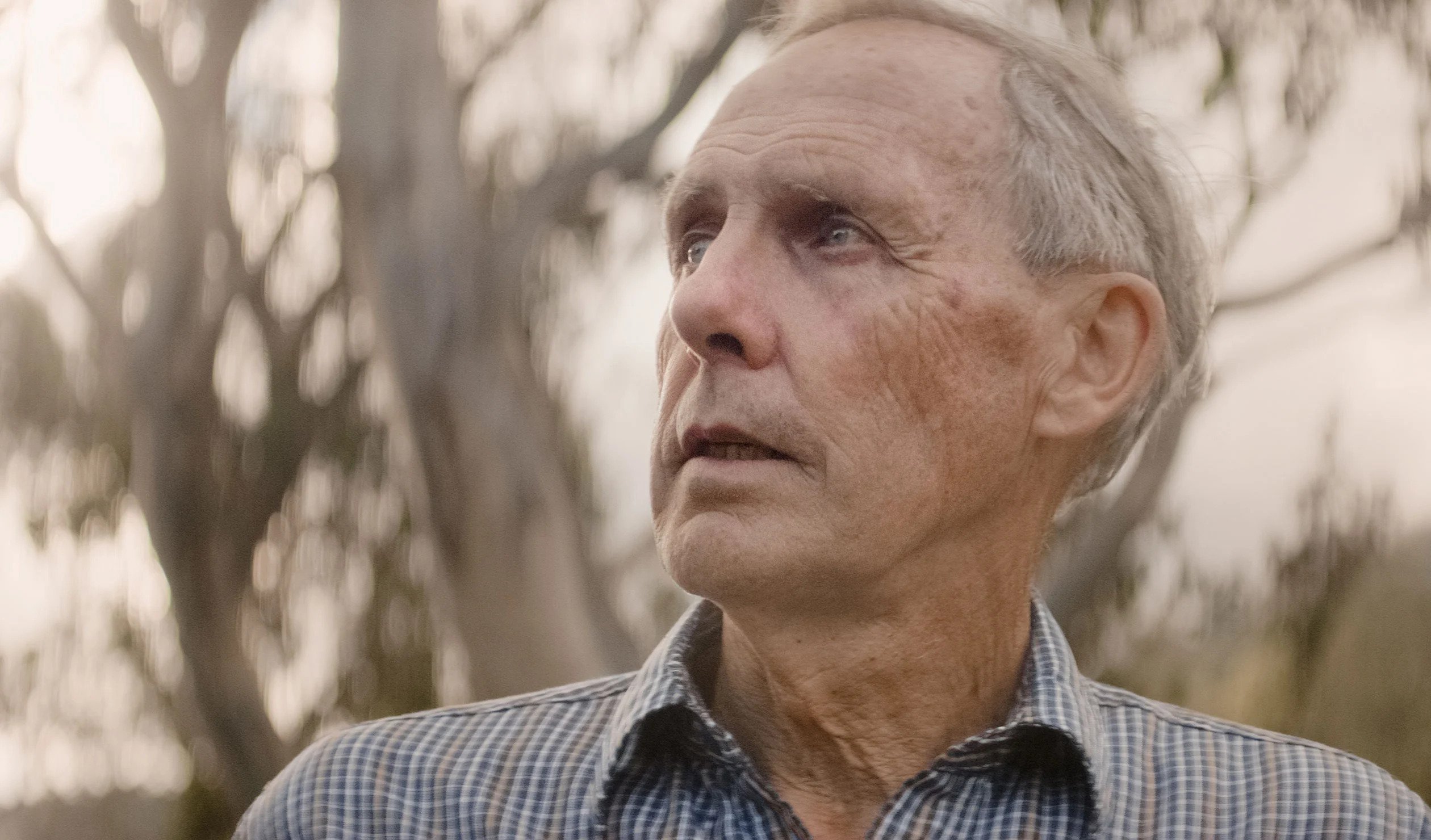“Can you imagine Australia without Bob Brown?” says Christine Milne in the biographical/ecological documentary The Giants by co-directors Rachel Antony and Laurence Billiet. A young doctor moved to Tasmania in the 1970s and became a beacon of hope to generations of not just people, but generations of old growth forest, vital waterways and ecosystems that existed far before humanity. For many Tasmanians, and indeed Australians and international people, a world without Bob Brown would be a world without a visionary whose faith in nature led him to inspire countless conservationists and save vast amounts of precious landscape from destruction and short-term blinkered thinking.
There is a twin purpose in The Giants that reveals itself almost immediately. It is a tribute to Bob Brown, but any tribute to Bob Brown must pay tribute to what is essential to him – the environment. Telling Bob Brown’s story without contextualising what has driven a shy man to open protest, imprisonment, Parliament, near poverty, exhaustion, elation, and both acclaim and disdain, simply cannot be done. Rachel Antony and Laurence Billiet recognise the fact and spend as much time honouring and explaining what Bob Brown fights for to this day and how the interconnectedness of nature has inspired a man to create his own vast networks to ensure the survival of the wilderness.
The Giants begins with a heady mixture of sublime shots of Eucalyptus Regnans, the King of the Gums that then merge into spellbinding animation (by Alex Le Guillot) with voice overs describing the trees and their integral purpose in the ecosystem by such luminaries as David Suzuki. Blending the elements of a nature documentary with a biographical documentary is not an accidental decision by the filmmakers. In fact, if anything, The Giants almost functions as a biography for the forests, waterways, and trees it depicts. The “stars” of the film are Bob Brown, Eucalyptus Regnans, Huon Pine, and Tasmanian Myrtle Beech. Each essential to their particular region, and each part of an ecosystem that is measured in generations – trees, like humans, have families. Suzuki points out they have sophisticated networks to communicate with each other that we are only just beginning to understand. They are not only alive; they are part of a community.
The focus moves to Bob Brown and his early life in the Blue Mountains with his father and mother, and especially his twin sister, Jan. Bob came into the world as his policeman father was out fighting a bush fire. His parents were conservative but not restrictive. They were members of a church which taught Bob what he considered ‘The Golden Rule’ – do unto others. Bob was a shy but clever boy who did well at school until he was abused by a teacher. Moving to a new school he began once more to thrive and was popular attaining the position of School Captain. Although he liked school his passion early on was nature, more than his passion, his spirituality. Throughout his life he had a crisis of religious faith but always saw nature as the healing entity.
Bob struggled for years with his sexuality. Being homosexual was punishable with prison sentences and he even underwent conversion therapy which he says bluntly “made zero difference.” After graduating medical school in Sydney, he went to London where he met a psychologist who suggested he just accept himself, which he did. When Bob was already a well-known environmental activist he decided to come out as publicly gay at age 31. He believed that his position as a medical doctor gave him a platform to represent his community and despite considerable personal risk, Bob was, as ever, brave.
Moving to Launceston in 1972 to run a small practice became a watershed moment for Bob. From his cottage which he lived in for thirty-eight years (now donated to the Heritage Fund including the land around it) he realised that he needed to devote himself to his true passion – the environment. The same year he joined the fledgling United Tasmania Group, the first political environmental action organisation. He fought (and lost) against the flooding of Lake Pedder and in 1976 he conducted a fast atop Mount Wellington protesting the arrival of the nuclear warship The USS Enterprise. Although these appear to be dry facts the manner in which Anthony and Billiet present the information is anything but. The audience sees the emergence of a man who will become a giant in conservation. A man who never sought the spotlight but also knew he had a duty to act on behalf of nature, to become the voice that few people heard as nature cried out and that humans were ethically bound to speak for.
Archival footage shows Bob and his fellow activists who included the Pulitzer Prize winning author and journalist Geraldine Brooks, co-founder of the Tasmanian Wilderness Society Karen Alexander, and Paul Smith as they worked together on what would become a landmark case in Australian history, the protection of the Franklin River from a hydro-electric dam. Over his years of direct action Bob learned with his comrades how to protest in a non-violent manner, yet he still ended up imprisoned as did fellow protesters. Imprisonment was one of the methods to bring attention to the fight to save the Franklin, the others, guided by Brown’s vision were to bring the natural beauty of the Franklin into every home in Australia, and indeed as far across the world as possible. A famed image of Rock Island by Peter Dombrovoskis became a fixture in thousands of Australian homes.
The long campaign to save the Franklin became seared into the Australian consciousness. Tasmania remains a somewhat small community and it was deeply divided on the issue. Liberal Premier Robin Hardy was adamant that Tasmania’s “resources” be harnessed. For many in Tasmanian that meant jobs and the Green movement was just noise stopping progress. Families became at odds with each other as the conservationist movement became more pronounced. Bob Brown and his fellow activists had lit a fuse that ignited protest and soon Bob would be a politician, something he reluctantly accepted as a necessity.
The fight for the Franklin River is well documented, especially in Kasimir Burgess’ film Franklin which is a stunning companion piece to The Giants. Both documentaries allow the subjects to reflect on what the river means, not just as a place of historical and environmental significance, but as a representation of how interconnected the natural world is, and how nature’s ability to ‘network’ with the elements is a symbol and a method that humans should learn from.
Never forgetting what Brown is fighting for The Giants continually refers back to the Tasmanian wilderness. Experts explain mycelium networks which are illustrated by the luminous cinematography of Sherwin Akazbarzadeh and Alex Le Guillot’s animation. From close-ups on the floor of forests to aerial shots of rivers and tree canopies, the audience is afforded a vision of micro and macrocosmic world of places like Tarkine (Takayna) Forest which indigenous scholar Therese Sainty reminds us is stolen Aboriginal land. The documentary might be focused on Bob Brown, but it doesn’t posit him as a sole “white saviour,” there are many voices which speak of and to Country.
Following Brown’s political career, we see him become the first Tasmanian senator outside of a major party. We also see the formation of The Greens as a political party and hear from Christine Milne and the struggles she faced as a woman in politics. Brown and the Greens never rested on their laurels – when it came time to fight deforestation they fought. When it came time to stand up against the Iraq war, they fought. When it was time to fight for LGBTI rights, they fought (in particular this brings into the documentary Brown’s life partner Paul Thomas and the Salamanca protests). They spoke up against mining, they spoke up against brutal treatment of refugees during the Howard era. The Greens acted as a national conscience which had conservatives calling for them to be stuffed into a chaff bag and dumped into the sea, with even one commentator comparing Brown to Hitler.
There are many battles that Bob Brown didn’t win. The carbon tax he negotiated with Gillard to put into place was immediately repealed by Tony Abbott. As much as he tried to shift Australia’s focus to the climate emergency conservative governments began to enact draconian anti-protest laws. However, even within what seem like losses Bob Brown planted a seed. Like the seeds of the Eucalyptus Regnans that pass down through generations to create new life, Bob Brown’s bravery has passed on to a new generation of climate activists.
Twenty-five percent of Tasmania is now World Heritage Listed and protected because of Bob Brown, and through The Bob Brown Foundation and Bush Heritage Fund more land is being purchased to be protected. At one stage in the documentary a young schoolteacher Miranda Gibson saves a forest from logging by spending almost 450 days in a tree. Miranda spoke to Bob and he supported her emotionally and practically during her protest. To this day Bob advises activists and provides them with support and resources.
“Defiance is defying the impulse to think it’s all too much,” says Bob. In a world where it can often seem all too much Bob Brown’s example shines. The Giants is proof that idealistic outsiders can make a concrete difference in the world. Yes, Australia is lagging behind other countries in climate policy, in fact Australia has a dismal political record of pro-climate activity. The country still fells old forests for woodchips despite it being not even financially viable. The toll human beings have taken on the environment can be read in tree trunk lines; dendrochronology gives us a timeline for how quickly we are pushing the environment to extinction. Australian biodiversity is dying at a rate that is shocking and it seems that humans are content to destroy with a perverse fecklessness. And yet, and yet…
And yet the Giants of the forest still preside in magnificence and feed the land and are fed off it. Bob Brown reminds us that the most sacred thing we have is the natural world and he is passing the torch to new generations of activists who are emboldened by his example. The Giants is a testament to Brown and a testament to nature’s ability to heal and nurture not only itself, but humans when they give it the opportunity. The clock is ticking but while we are here we must make time to connect to the earth and ask ourselves “What did you do?” The Giants is a rallying call and it is one that refuses to be ignored.
Directors: Rachel Antony, Laurence Billiet
Featuring: Bob Brown, Christine Milne



